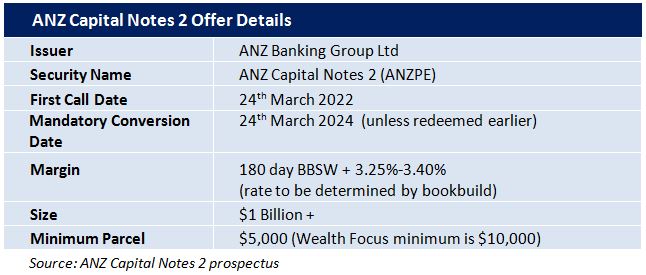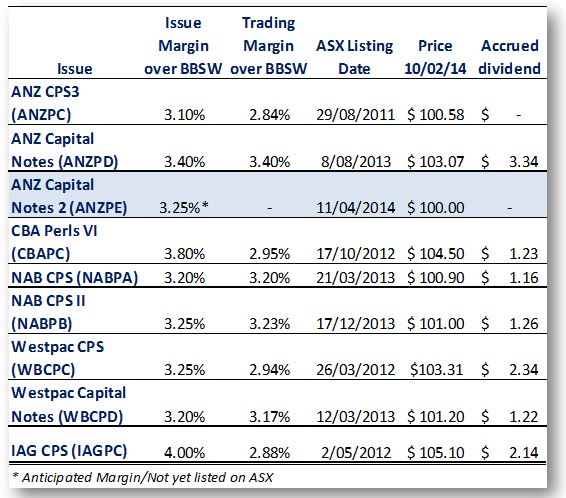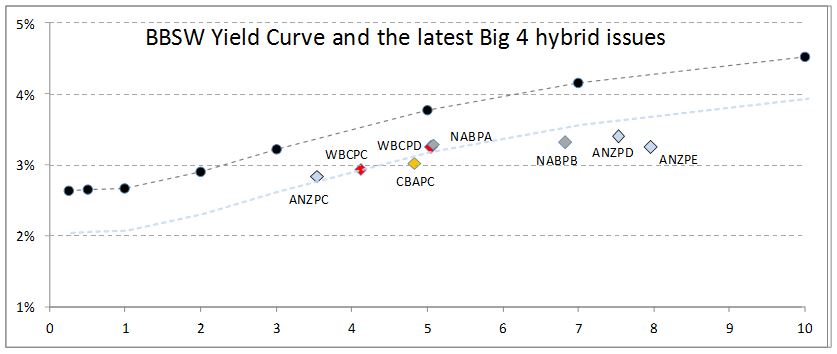ANZ Bank has just announced the launch of a new income offer: ANZ Capital Notes 2.The first round of access is through a broker firm allocation, prior to shareholder offer and listing in August.
The Notes will pay a semi annual coupon of 3.4%-3.6% (rate determined by the bookbuild) over the 180 day bank bill swap rate (BBSW), which was 2.82% as of 2nd July, with an initial indicative rate of 6.22%-6.42%pa. (The first pricing is due to be set on date of issue) The Notes are expected to redeem on the 24th March 2022** and will be tradable on the ASX.

** It is expected that the issue will be repaid at the first opportunity in March 2022 with a scheduled conversion in 2024 (subject to mandatory conditions not being breached).
We have covered the features in of fixed income hybrids on numerous occasions over the last 2 years. We would suggest investors who are looking for a basic understanding of how these products work, watch our online video An Introduction to Fixed Income
Comparative Securities
The structure of this issue is almost a carbon copy of last year’s ANZ Capital Notes (ANZPD), maturing 6 months later. As with other recent issues, ANZPD contains capital and non-viability conversion clauses to satisfy APRA’s harder in the event that the bank falls on hard times.
ANZPC, ANZPD, NABPA & WBCPC structures offer a margin over the 180 day BBSW, NABPB, CBAPC and WBCPD offer a margin over the 90 day BBSW.
Our analysis
If this is starting to sound like we’ve said this all before, that’s because we have. The formula for issuing new hybrids is now tried and tested with many of the clauses and conditions replicated in the new issues.
ANZPD currently trades at $103.07 including a $3.34 accrued dividend (ex. div on 17th March 2014), with an effective margin to expected maturity of just over 3.40%pa. NABPB, the next closest comparable, trades at an effective margin of 3.23%pa over the BBSW.
The main difference is ANZ Capital Notes 2’s slightly longer duration and investors should expect to be rewarded with a higher rate to compensate them for the longer duration.
As shown in our previous reviews, we have used the Bank Bill Swap Rate (BBSW), the rate that banks’ lend money to each other at, to use as a reasonable basis of how much you should expect to be rewarded for the extra duration. This would indicate 3.65% is a fair margin. If we consider that the wholesale bond market yield curve is slightly flatter, we would assess a fair margin as 3.45%-3.55% over the BBSW
The yields reflected are notional yields to maturity – Margins have been manipulated to reflect the benefit of quarterly payments over semi annual payments.
Non-viability Clause, Capital Trigger Event and Inability Event
We wouldn’t be doing you justice if we didn’t again highlight that the new hybrid’s now contain non-viability and capital trigger clauses that should the bank’s Tier 1 Capital Ratio fall below 5.125% or APRA views the bank as non-viable without an injection of capital, the hybrids would automatically convert to ordinary shares.
The most recent bank hybrids have seen a further Inability Event Clause added which states that in the event that the issuer is unable to issue further ordinary shares, ie the company has ceased trading, a Capital Trigger Event or Non-Viability Event, hybrid note holders lose their investment.
Although this is extremely unlikely but reflects the continued increase in risk of the latest bank hybrid offerings. Investors should ensure they get paid a premium for the additional risk they are taking.
For those looking for view of how much you should be getting paid for this additional risk.
It is our view that the institutional investors have generally got a good handle on how much you should be rewarded. The institutional market prices this at around 0.3%pa.
Our View on ANZ Capital Notes 2
This is clearly another issue written by Lawyers to the banks, Messrs Cut and Paste. The banks are now clearly aware that retail investors view these issues very differently to wholesale investors are filling their boots with lower rates than they would be expected to pay for an equivalent offer in the wholesale market.
There are some with the view that hybrids don’t reward investors for the risk of investing in this asset class, however, with cash returns dropping so significantly, retail investors who aren’t willing to ride the equity roller coaster are limited in their options and are continuing to buy each of the hybrid issues offered by the Big 4.
The latest trend in these issues has been to lengthen the maturity date, this is partly for the purposes of how the credit ratings agencies view these issues. We have continued to say investors need to be rewarded for the longer term, yet the new issues have been priced in line with or at a lower margin than the comparable shorter term issue on market.
We have expected some of these issues to list and investors switch buying to the better value, shorter term comparable, however, recent issues such as NABPB have surprised us in continuing to rise post listing. We can only surmise that the retail market views the longer term as an opportunity to lock in historically high margins before they eventually contract. Like we said, retail investors are behaving differently to wholesale investors.
We are in no doubt, ANZ will successfully raise the funds they’re looking for at the bottom end of the range (3.25%-3.40% over the 180 day BBSW). Our view is we would like to see this in excess of 3.45% over the BBSW, but we said the same about NABPB and investors continued to buy this post listing!
In short, although we’re not particularly enamoured by this issue but it’s likely to highly sought after. We think ANZPC, listed on market offers better value, but you’ll have to pay brokerage to buy it.
Contact us if you would like an allocation to ANZ Capital Notes 2.
Key features
- Indicative floating yield of 5.92-6.07%pa – based on current 180 BBSW of 2.67% and bookbuild margin range of 3.25-3.40%.
- Option to redeem at year 8 with scheduled conversion at year 10 –ANZ has the option to convert in March 2022 or on any subsequent dividend payment date.
- Ordinary dividend restrictions –applies on the non payment of ANZPE dividends
- Automatic conversion under the Capital Trigger Event and Non-Viability
- Redemption highly likely in 8 years –although ANZPE has a 10 year maturity, we think ANZ will redeem/convert at the first call date in March 2022. Major incentives for redemption/conversion include the potential for reputational damage and risk of credit rating downgrade, leading to an increased cost of funding on future debt issues.
Note: ANZ Capital Notes 2 will be listed on the ASX and as such the price of the Note’s will be subject to market movements. Investor’s selling on market may receive a price lower (or higher) than the issue price.
Investors looking for an allocation can contact us on 1300 559 869
We encourage you to view our online presentation An Introduction to Fixed Income
Best regards
Sulieman Ravell
Wealth Focus Pty Ltd



Comment: